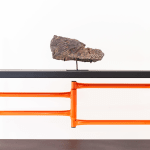Groundbreaking
















Unknown
9 7/8 x 4 7/8 x 1 3/4
1.585kg
Further images
-
(View a larger image of thumbnail 1
)

-
(View a larger image of thumbnail 2
)

-
(View a larger image of thumbnail 3
)

-
(View a larger image of thumbnail 4
)

-
(View a larger image of thumbnail 5
)

-
(View a larger image of thumbnail 6
)

-
(View a larger image of thumbnail 7
)

-
(View a larger image of thumbnail 8
)

-
(View a larger image of thumbnail 9
)

-
(View a larger image of thumbnail 10
)

-
(View a larger image of thumbnail 11
)

-
(View a larger image of thumbnail 12
)

-
(View a larger image of thumbnail 13
)

-
(View a larger image of thumbnail 14
)

-
(View a larger image of thumbnail 15
)

-
(View a larger image of thumbnail 16
)

This is a fantastic richly detailed crinoid fossil on original die. It is believed to from the geological period in which animal life made begun the transition from the oceans to the land. Both sides feature remains of this very ancient animal. The block is mounted on a metal base.
The Devonian period is geological period from the Paleozoic era. It spans 60.3 million years from the end of the Silurian period, 419.2 million years ago, to the beginning of the Carboniferous, 358.9 million years ago. The term ‘Devonian’ is named after Devon, the county in southwestern England, where a controversial argument in the 1830s over the age and structure of the rocks found distributed throughout the county was eventually resolved by the definition of the Devonian Period in the geological timescale. Sea levels in the Devonian were generally high and the plethora of many vertebrate and non-vertebrate fish and sea life and abundance of crinoids has led to the Devonian being given the name "The Age of Fish" in popular culture.
From the middle to late Devonian period the shallow, warm, oxygen-depleted waters of Devonian inland lakes, surrounded by primitive plants, provided the environment necessary for certain early fish to develop such essential characteristics as well-developed lungs, and the ability to crawl out of the water and onto the land for short periods of time. By the late Devonian period the first forests begin to appear on land and the first tetrapods, four legged animals, begin to appear on the fossil record. This leads to the popularised image of the Devonian period as the period in which animal life, as we know it, crawled from the sea and colonised the earth.
Crinoids are marine animals that make up the class Crinoidea, one of the classes of the phylum Echinodermata, which also includes the starfish, brittle stars and sea urchins. Though they are classed as an animal – due to the fact they have a mouth, a gut and an anal vent - they are most commonly misunderstood, due to their appearance, as a plant. Crinoids which, in their adult form, are attached to the sea bottom by a stalk are commonly called sea lilies, while the unstalked forms are called feather stars.
Adult crinoids are characterised by having the mouth located on the upper surface. This is surrounded by feeding arms. Although the basic echinoderm pattern of fivefold symmetry can be recognised, in most crinoids the five arms are subdivided into ten or more. These have feathery pinnules and are spread wide to gather planktonic particles from the water. At some stage in their lives, most crinoids have a stem used to attach themselves to the substrate, but many live attached only as juveniles and become free-swimming as adults.
There are only about 600 living species of crinoid, but the class was much more abundant and diverse in the past. Some thick limestone beds dating to the mid-Paleozoic to Jurassic eras are almost entirely made up of disarticulated crinoid fragments.
In mediaeval Northumberland, the fossilised columnal of Crinoid fossils began to be collected at Lindisfarne, and were strung together as a necklace or rosary. Over time, they became associated with St. Cuthbert, who was a monk on Lindisfarne and the nearby island of Hobthrush during the 7th century and became Bishop of Lindisfarne. In ‘The Legend of St Cuthbert’s Beads: A Palaeontological and Geological Perspective.’ Researchers Gary Lane and William Ausich suggest that the beads were not associated with St. Cuthbert before the 12th century and may have become popular after a limestone quarry came into operation on Lindisfarne in the 14th century.
However the first known reference to Cuthbert's beads in a documentary source has not been found until an account of a visit to Lindisfarne by a John Ray in 1671:
July the 22nd we rode from Cheviot, or rather Waller or Wooler, to the Holy Island, nine miles, where we gathered, on the seashore under the town, those stones which they call St Cuthbert's beads, which are nothing else but a sort of entrochi.
At the time, the origin and nature of the "beads" was not well known. The term "St Cuthbert's beads" became a common way of referring to crinoid columnal from the 17th century onwards, and it is a term which is still used occasionally in palaeontological writings. In the United States the fossils are colloquially referred to as ‘Indian Beads’ or ‘Indian Money’ because of the way the vast crinoid fossil deposits, often found in the American mid-west and in gravel, naturally lend themselves to beading.
Provenance
Private Collection, Italy, 2021Excavated in Morocco
Hello World.
Join the journey. Register with HALLE13.
You will receive exclusive access.
Upcoming exhibitions annoucnements, invites to exclusive events, weekly essays, amazing art and more!.
No spam only substance.